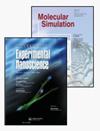Simulations of the thermodynamic properties of the helium fluid from the state-of-the-art ab initio potentials and their uncertainty estimation
IF 2
4区 化学
Q4 CHEMISTRY, PHYSICAL
引用次数: 0
Abstract
ABSTRACTThe molecular dynamics simulation method is used to study the internal energy, pressure, isochoric heat capacity, and sound speed of helium based on the state-of-the-art ab initio potentials. The simulations cover a wide temperature and density range of (20–2000) K and (0.0005–70) molL−1. The uncertainty of simulation data are evaluated based on the uncertainty of the potential and the uncertainty of the simulation method. At temperatures below 300 K, the quantum Feynman-Hibbs modified potential and the Wigner-Kirkwood modified potential are introduced and the results are almost the same as those by the original ab initio potential. The modified potentials can not reasonably describe the quantum effects for the helium fluid at low temperatures, which become obvious below 200 K. The two-body ab initio potential is combined with the three-body ab initio potential to evaluate the influence of multi-body interactions at high densities. When the density is lower than 45 molL−1, the contribution of the three-body term to our simulation data is not significant. As a result, the three-body potential is omitted in our calculations to improve the overall computational efficiency. The thermodynamic property data of this work show agreement with the experimental data in the literature as well as the NIST Refprop 10.0 data at temperatures above 200 K and densities below 45 molL−1.KEYWORDS: Helium fluidthermodynamic propertyab initio potentialmolecular dynamicsuncertainty Disclosure statementNo potential conflict of interest was reported by the author(s).Additional informationFundingThis work was supported by the National Natural Science Foundation of China [grant number 51936009] and the Natural Science Basic Research Program of Shaanxi [grant number 2022JQ-393]从最先进的从头算势及其不确定度估计的氦流体热力学性质的模拟
摘要基于最先进的从头算势,采用分子动力学模拟方法研究了氦的内能、压强、等时热容和声速。模拟覆盖了(20-2000)K和(0.0005-70)molL−1的温度和密度范围。从势的不确定性和仿真方法的不确定性两个方面对仿真数据的不确定性进行了评价。在低于300 K的温度下,引入了量子Feynman-Hibbs修正势和Wigner-Kirkwood修正势,结果与原始从头算势基本一致。修正势不能合理地描述氦流体在低温下的量子效应,在200 K以下变得明显。将二体从头算势与三体从头算势相结合,评价了高密度下多体相互作用的影响。当密度低于45 mol / l−1时,三体项对模拟数据的贡献不显著。因此,我们在计算中省略了三体势,以提高整体的计算效率。在温度高于200 K,密度低于45 molL−1时,本工作的热力学性质数据与文献中的实验数据以及NIST Refprop 10.0数据一致。关键词:氦流体热力学性质,初始计算,潜在分子动力学,不确定性披露声明作者未报告潜在的利益冲突。基金资助:国家自然科学基金项目[批准号:51936009]和陕西省自然科学基础研究计划项目[批准号:2022JQ-393]
本文章由计算机程序翻译,如有差异,请以英文原文为准。
求助全文
约1分钟内获得全文
求助全文
来源期刊

Molecular Simulation
化学-物理:原子、分子和化学物理
CiteScore
3.80
自引率
9.50%
发文量
128
审稿时长
3.1 months
期刊介绍:
Molecular Simulation covers all aspects of research related to, or of importance to, molecular modelling and simulation.
Molecular Simulation brings together the most significant papers concerned with applications of simulation methods, and original contributions to the development of simulation methodology from biology, biochemistry, chemistry, engineering, materials science, medicine and physics.
The aim is to provide a forum in which cross fertilization between application areas, methodologies, disciplines, as well as academic and industrial researchers can take place and new developments can be encouraged.
Molecular Simulation is of interest to all researchers using or developing simulation methods based on statistical mechanics/quantum mechanics. This includes molecular dynamics (MD, AIMD), Monte Carlo, ab initio methods related to simulation, multiscale and coarse graining methods.
 求助内容:
求助内容: 应助结果提醒方式:
应助结果提醒方式:


